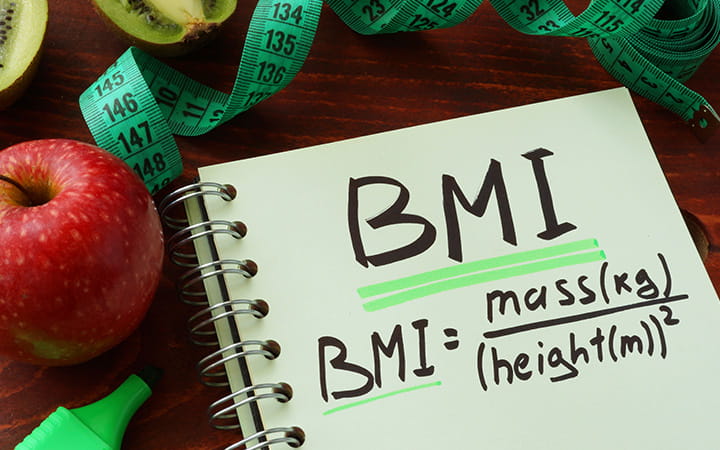Should We Stop Using BMI to Measure Health?
August 16, 2022

A person’s body mass index, or BMI, varies widely based on their build, bone mass, and muscle-to-fat ratio. Many people categorized as overweight or obese by their BMI may have normal bloodwork and other health markers, while some in the healthy BMI range don’t. This often creates unnecessary body shame and stress. Yet many still use BMI as the guide for healthy weight.
“The real question is, how do we accurately assess body weight as a risk factor for health, and are the measurements we currently use the best options?” says University Hospitals comprehensive weight management specialist Megan Purcell, FNP-C, RD, LD.
BMI Basics
For adults, BMI is calculated by using a person’s weight (in kilograms or pounds) and height (in meters or inches). The resulting number, or BMI, falls into a range of either: underweight (<18.5), normal (18.5 – 24.9), overweight (25 – 29.9) or obese (≥30).
The ranges were developed in the early 19th century, but didn’t come into common use until the 1970s. That’s when researchers noticed that BMI, especially higher BMI, seemed to correlate with increased body fat and the health-related problems associated with it.
“BMI is a measurement,” says Purcell, “and like a lot of measurements in epidemiology research, it is not perfect. That’s because it only looks at a person’s height and weight.”
What BMI Doesn’t Calculate
BMI isn’t able to account for the body composition differences between fat and lean muscle mass. For example, men and athletes of either sex may have more muscle mass than women in general. Because muscle weighs more than fat, people with more muscle mass weigh more. This increases their BMI, often landing them in the overweight or obese range, when, in fact, they may be healthier than those with less muscle and lower BMIs.
BMI also doesn’t account for the impact that age, gender or body frame may have. A light or heavy bone structure or body frame can skew BMI toward inappropriate results. Additionally, where a person carries excess fat – in the stomach area (the apple-shaped body type) or in the hips (the pear-shaped body) – is also a significant factor in health that can’t be evaluated with BMI.
“We know that central obesity, which means a waist circumference of greater than 40 inches for men and greater than 35 inches for women, is associated with a higher risk for chronic disease and metabolic conditions such as type 2 diabetes, fatty liver disease, high blood pressure and others,” says Purcell.
Other Tools to Evaluate Weight and Health
Because of the limitations of BMI to evaluate body fat percentage and a person’s risk for chronic disease, other tools can be helpful in assessing a healthy weight. Two measurements that can be done in a physician’s office or at home:
- Waist circumference measurement. Use a tape measure over bare skin or a thin layer of clothing. Measure midway between your lowest rib and the top of the hipbone, about in line with or just above your belly button. Hold the tape level and snug. Breathe out and measure. For women, the measurement should be 35 inches or less, and for men, 40 inches or less.
- Waist-to-hip circumference ratio. Take your waist measurement as above. Then measure your hips, placing the tape at the largest part of your buttocks. Divide your waist measurement by your hip measurement. The result is your waist-to-hip circumference ratio. For women, the ratio should be 0.8 or less, and for men, the ratio should be 1.0 or less.
Two other tools are the DEXA scan and caliper measurements. DEXA, which is a bone density scan, can be used to evaluate overall body composition. Calipers are used to measure skin fold thickness to evaluate fat in various body areas, but these measurements require a well-trained professional to get accurate results.
Whether your BMI is in a healthy or unhealthy range, these tools can help determine the amount of lean body mass vs. fat tissue and its potential for health risk.
BMI: A Great Starting Point
“BMI is a valuable metric,” Purcell says. “While recognizing that it has limitations, BMI is a great starting point for a discussion that every patient should have with their health care provider because weight is a key factor in health.”
Every patient, especially if weight is a concern, should ask: What is my BMI? Where do I fall on the chart? If your BMI seems troubling, ask if a waist circumference, waist-to-hip ratio measurement, or some other tool would help to better evaluate your health risks. Together, you and your health care provider can develop a plan and you can be empowered.
Related Links
University Hospitals Digestive Health Institute’s Nutritional Health & Bariatric Surgery Center is the only program in Northeast Ohio with three accredited bariatric centers. Our experts can help patients lose weight by conventional means such as dietary and lifestyle changes or through surgical interventions.


